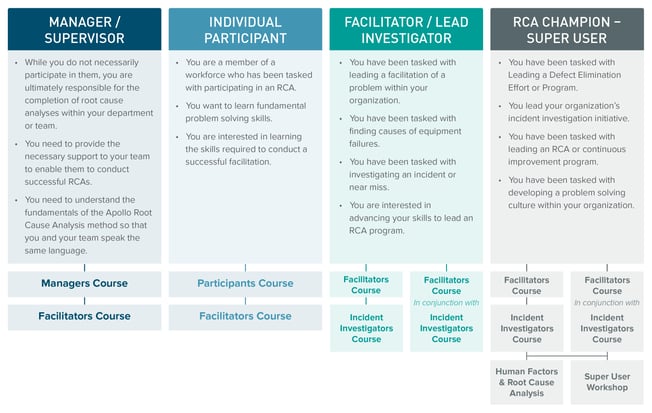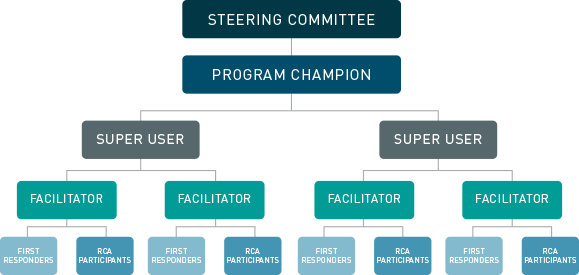This is our sixth installment in our blog series on Root Cause Analysis Program Development. Earlier in the series we introduced the six necessary functions within an RCA program and then outlined a recommended team structure to fulfill those functions. In this article, we’ll provide a detailed description of the part each of the six roles plan within an effective RCA program.
Let’s dive right in.
The RCA Steering Committee
It is the responsibility of the Steering Committee to develop and oversee the strategic functions of the RCA effort. Steering Committee members should collectively have the authority to assign RCA roles and responsibilities, allocate resources to the eff ort, and most importantly, have a vested interest in the success of the program.
ort, and most importantly, have a vested interest in the success of the program.
Leadership teams of this nature usually already exist in almost all organizations and as such, can double as the Steering Committee by simply adding RCA program status review to regularly scheduled routine meetings as an agenda item. This avoids the creation of more bureaucracy and duplicate meetings. Steering Committee responsibilities and functions are as follows.
Strategic Responsibilities:
- Define the scope and breadth of the RCA effort
- Assign RCA roles and responsibilities
- Review and approve RCA resource requirements for annual budgeting purposes
- Set and adjust program KPI’s (at least annually) to reflect improvements in the organization’s performance
- Set and review threshold criteria (at least annually) to ensure proper balance between trained RCA facilitators and formal RCA demand
- Sponsor a human change management plan where needed to ensure support from affected positions and departments.
Tactical Responsibilities:
- Approve (or not) recommended RCA solutions for implementation including prioritization and resource allocation
- Monitor status of open RCAs
- Monitor and ensure timely implementation of approved RCA solutions
- Monitor the effectiveness of implemented solutions
The RCA Champion
The Champion serves as a primary sponsor of the RCA effort. The Champion’s key functions are to promote the RCA effort through sustained advocacy and to make recommendations to the Steering Committee for the resources necessary for the tactical maintenance of the program. Primary responsibilities include the following.
Advocacy:
- Monitor RCA solution impact on the program KPIs and regularly communicate these results throughout the organization
- Promote a spirit of success by recognizing and celebrating specific RCA team’s accomplishments and contributions to the organization
- Attract individual interest in having a role in the RCA effort by communicating its career enhancement value and benefits to the organization
Tactical Resource Recommendations:
- Make recommendations to the Steering Committee for RCA program resource requirements for the budgeting process (man hours, positions, training, etc.) necessary to sustain a successful RCA effort
- Manage the organization’s overall RCA training schedule
- Regularly track the status of open RCAs and solution implementation
- Ensure the Steering Committee has accurate and up-to-date RCA and solution status data to make informed decisions regarding allocations of resources and action item prioritization.
The Super User
Depending on the size and structure of the organization, the role of Super User may be beneficial. The Super User is the level above Facilitator in terms of formal RCA training, experience, and expertise with both the RCA methodology and any supporting software. They will also have advanced group facilitation skills and should also be the most experienced facilitator on site. It is not uncommon to combine the roles of Super User and RCA Champion. Super User responsibilities include the following.
- Facilitate, or assisting in facilitating, the more significant events and complicated analyses for the organization
- Performing critical quality assurance reviews of other facilitators’ analysis
- Act as a mentor to new facilitators
- Ensure that all facilitators use the proper RCA methodology
- Deciding, in conjunction with the Champion, when to recommend bringing in facilitation assistance from impartial third-party experts.
The RCA Facilitator
The RCA Facilitators, or methodology practitioners, are fundamental to leading the RCA team in discovering the causes of the incident under review and associated preventative measures or solutions. The Facilitator needs to be neutral in the process. Too often facilitation duties are assigned to positions or individuals because of their technical skills, which can be a mistake. Facilitation skills and technical expertise are two distinctly different talents. Quality RCA facilitators have a naturally engaging personality, logical thought processes, superior group management techniques, and mastery of the RCA methodology. They must create effective RCA team dynamics by ensuring that all team participants are heard, keeping dominate personalities in check, and avoiding group think. Technical responsibilities include ensuring the RCA methodology is accurately followed which includes:
- Creating a clear and precise problem definition
- Ensuring that all incident causes are identified and documented in the proper causal relationships
- Encouraging “out of the box” thinking of the team members during the solution identification process
- Summarize the results of the RCA with recommended solutions for submittal to appropriate personnel
The RCA Participant
The Participants' primary role is to be an RCA team member when called upon to do so. They can be anyone from hourly employees, to upper level managers and every position in between. Participants need to receive a level of training on the RCA methodology such that they understand the terminology and the steps involved. Although the level of training is significantly less than that of the Facilitators, Participants often comprise the bulk of the trainees because of the diversity of the personnel requirements for the various RCA incidents. Responsibilities often include the following:
- Maintain a fundamental understanding of the RCA methodology employed
- Participate as an RCA team member when called upon
- Apply their own specific knowledge, skills, and expertise in identifying incident causes
- Assist in identifying and gathering incident evidence as directed
- Participate in the solution identification process
The First Responders
The role of a First Responder is to gather as much information and preserve as much evidence as reasonably possible when a trigger incident occurs. This role is especially important for 24/7 manufacturing operations. Since response time is often critical to preserving evidence, it is important that First Responders be readily available to serve in this role. For such operations, typical First Responders are shift supervisors, lead hands, shift maintenance personal, etc. Activities of the First Responders primarily include:
- Notifying appropriate personnel that a triggered RCA event has occurred
- Securing incident information and evidence for the RCA team which may include:
- Taking photographs if applicable
- Identifying eye witnesses for debriefing by the RCA team
- Securing electronic data related to the incident in question
- Preserving any physical evidence relative to the incident
By understanding the responsibilities of each of these roles, you can ensure that the appropriate personnel are assigned to the proper roles, while at the same time, balancing existing position duties with any added RCA responsibilities.
So far, this blog series has covered:
The Key Steps of Designing Your Program
Defining Goals and Current Status
Setting KPIs and Establishing Trigger Thresholds
RCA and Solution Tracking and Roles and Responsibilities
Recommended RCA Team Structure
And, descriptions of each of the six roles within an RCA program.
Next up – Training Strategy and RCA Effort Oversight and Management. Stay tuned for more.
 The previous article in our blog series described the recommended training strategy for your RCA program development. The next step in achieving a successful RCA program is to ensure leadership understands their role and has the tools in place to ensure the longevity of the program and its effectiveness.
The previous article in our blog series described the recommended training strategy for your RCA program development. The next step in achieving a successful RCA program is to ensure leadership understands their role and has the tools in place to ensure the longevity of the program and its effectiveness. Once a root cause analysis has been completed, a list of potential solutions will be developed by the RCA team and submitted to the Steering Committee via the Program Champion or his/her designee for approval. The Steering Committee then assigns these solutions to individuals for completion and puts them into an action plan format with assigned due dates. These actions should be completed in the shortest time possible, otherwise the process will quickly fade away. The Steering Committee must track the status of open RCAs, the progress of implementing the solutions to ensure timely completion, and the effectiveness of previously implemented solutions (as measured by recurrences of the original incidents). New analyses should not be started if a large number of solutions remain to be implemented.
Once a root cause analysis has been completed, a list of potential solutions will be developed by the RCA team and submitted to the Steering Committee via the Program Champion or his/her designee for approval. The Steering Committee then assigns these solutions to individuals for completion and puts them into an action plan format with assigned due dates. These actions should be completed in the shortest time possible, otherwise the process will quickly fade away. The Steering Committee must track the status of open RCAs, the progress of implementing the solutions to ensure timely completion, and the effectiveness of previously implemented solutions (as measured by recurrences of the original incidents). New analyses should not be started if a large number of solutions remain to be implemented. 
 The previous article in our blog series on RCA Program Development described the
The previous article in our blog series on RCA Program Development described the 



 As outlined in our previous blog article, “
As outlined in our previous blog article, “

